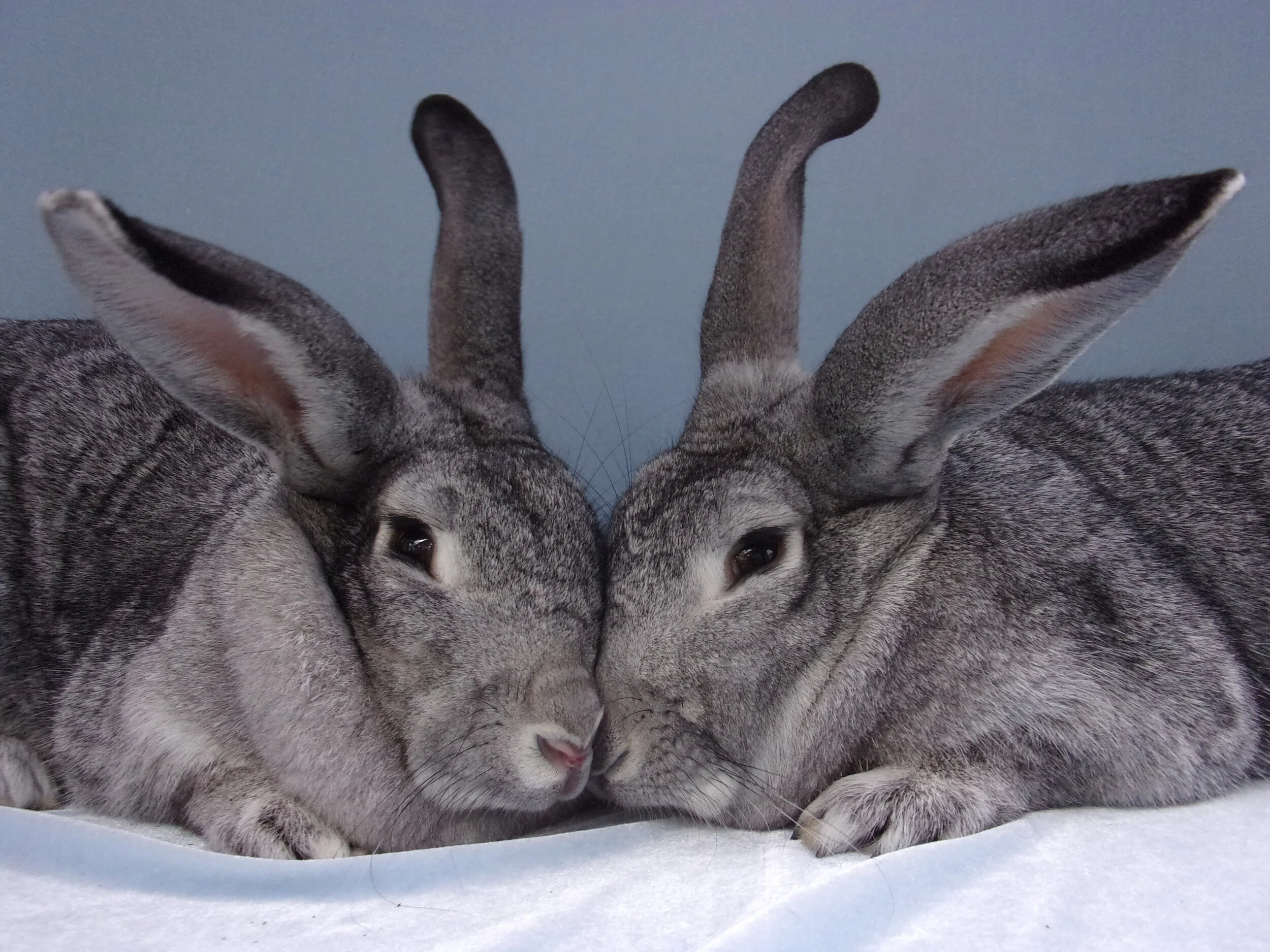
Rabbit Care
Preparing a home for your bunny
Furniture
Locking crocks will prevent your bunny from tossing its food and water. These may be ordered from Morton Jones or KW Cages for about $5.00 each. Ceramic crocks also work. Grass carpet squares from Pier One or a wooden sitting board should get the bunny's feet off the wire floor. This promotes healthy feet. Litter trained bunnies should have all wire covered. Others should have all but the toileting area covered. A plastic litter box full of hay or paper litter can be used for toileting, napping or digging. Some rabbits gnaw on their litter boxes too!
Toys
Add toys: a toilet paper roll, a ball, a stick to chew, a tin can, open an old phone book for digging. Does your bunny like to dig, toss, or climb? Make up toys and games based on your bunny's interests. You'll both have fun!
Exercise
Neither you nor your rabbit wants to be locked up all day. At least 4 hours a day outside the cage is a minimum. More is better. Outside your bunny should only be in a fenced area that is free from poisonous plants. Lists of poisonous plants are in Poisonous Plants of California available at the Botanic Garden Bookstore. Babies and dwarf rabbits should in runs covered with netting or screen, or they may be taken by hawks.
Indoors
Use a 30" by 36" wire cage, with urine guards, and a wire floor with a litter pan beneath. The door must be large enough to admit a litter box. Costs about $55. An alternative to a cage is a folding exercise pen which offers more room and has more uses. Costs between $30 to $50. Order from: Morton Jones (800) 443-5769 or KW Cages (800)447-CAGE.
Below is a sample bunny indoor habitat built from Neat Idea Cubes. These are available in some office supply stores. When using these cubes, please be sure to cover the floor with straw mats as the grid in Neat Idea Cubes is too big for flooring:
Protection of indoors
Place electrical cords out of the rabbit's reach. Cover cords with one or two layers of sea grass mats. Radio Shack at the Fairview Shopping Center sells tubing designed to hold electric cords. Some hardware stores also sell the tubing.
Protect carpets by using sea grass mats or grass carpet squares. Available at Pier One.
Provide fruit tree twigs (no avocado or apricot), untreated pine or untreated baskets for chewing. Sisal bird or cat toys are also good. Provide a large litter box of hay, newspaper or non clay litter for digging and toileting.
Outdoors
Outdoor housing is not recommended due to fatal insect carried diseases and predators capable of over turning a hutch.
Feeding Your Bunny
Feed as much forage hay or timothy hay as your rabbit wants; alfalfa is a poor second choice. Hay must be available at all times! BUNS., Petcetera, and La Cumbre Feed sell partial bales of grass hay. The Oxbow Hay Co. sells hay by mail: call (800) 249-0366. Rabbit pellets can be purchased at any pet store or feed store. Feed green pellets only; pellet mixes contain junk food. Even green pellets are designed for fast weight gain and should be limited.
Amount of pellets to feed your bunny:
2-4 lb rabbit 1/8 Cup daily
5-7 lb rabbit 1/4 Cup daily
8-10 lb rabbit 1/2 Cup daily
11-15 lb rabbit 3/4 Cup daily
As for vegetables, provide one heaping cup of fresh vegetables per 4 Ibs of body weight daily; three vegetables at each meal. Limit fruit to small amounts. Offer fresh, clean water at all times. Petromalt, fresh papaya or fresh pineapple can be given weekly (daily during molt) to aid in the digestion of fur and to prevent hair balls.
Litter Training
An indoor cage and litter boxes are necessities. Put a litter box in the cage corner the rabbit uses naturally. Fill the box with hay, shredded newspaper, or non-clay litter like Cat Country or Care Fresh. If the rabbit won't use it, experiment with the litter. Treats may be placed in the box and praise given when the bunny sits in the box. Once the rabbit is peeing in the litter box, select a small room or enclosed area. Place a second litter box in a corner. Add a few poops and a treat. Carry your bunny to the litter box. Sit back and watch your bunny. Use of the box should be praised. Rabbits will pee in the box, but their poops are less controlled. Sweep poops up. Peeing outside the box means back to the cage - right then! Do not strike your bunny. Clean up the pee with white vinegar. Move the box to the spot on which the bunny peed. If he chooses more than one spot, add more boxes. As he gets older, he will settle on one or two spots. As the rabbit becomes more reliable, give the rabbit more free time and larger space.
Cat Country Litter is available at Petcetera 890 Cactus Lane, Carpinteria or The Pet Barn, 3018 State St., Santa Barbara. Special order Care Fresh Litter at the Pet Barn.
Health
Spay & Neuter
Male rabbits are less aggressive and spray less if neutered. Female rabbits have an 80% rate of uterine cancer after the age of 3. Spaying will fix the problem. Spayed females dig and spray less.
Nail Trims
Keeping your rabbit's nails trimmed is necessary for proper health. This YouTube video teaches the proper method for trimming your rabbit's nails without using force.
Some people prefer not to trim nails, so BUNS. offers nail trimming for $5 at the Santa Barbara Animal Shelter.
Further Information
To obtain information on rabbit care or adoptions contact BUNS at 805-683-0521. Copies of the "House Rabbit Handbook" by Marinell Harriman are available in south coast libraries courtesy of BUNS. This book is an excellent source of information on rabbits.
Veterinarians
Northern Santa Barbara County Vets
Dr. Michael Harris
Lompoc Veterinary Clinic
1416 East Ocean Ave.
Lompoc, Ca 93436
(805) 736-6555
lompocvet.aahavet.org
map
Dr. Bob Dean
Santa Ynez Pet Hospital
3523 Numancia St.
Santa Ynez, Ca 93460
www.santaynezpethospital.com
map
Ventura Area Vets
East Ventura Animal Hospital
10225 Telephone Road
Ventura, CA 93004
805-647-8430
www.eastventuraanimalhospital.com
map
Low Cost Spay/Neuter
Mercy Spay Neuter Clinic
2252 Craig Drive
Oxnard, CA 93036
805-278-4433
http://www.dogcatfix.com/
map
Santa Barbara Area Vets
Dr. Greg Haskell
Adobe Pet Hospital
3230 State St, Santa Barbara
805-682-2555
map
Dr. William Otto
Carpinteria Veterinary Hospital
585 Walnut Street, Carpinteria
805-684-3617
map
Dr. Alexa McKenna
Dr. Christine Sellers
Cat & Bird Clinic
101 West Mission Street, Santa Barbara
805-569-2287
map
Dr. Michael Rittenberg
Foothill Pet Hospital
675 Cieneguitas Rd, Santa Barbara
805-967-0119
map
Dr. Amanda Lumsden
Mobile Cat Calls Veterinary Home Care
www.mobilecatcalls.com
805-895-2287
Dr. Evelyn Brand
Dr. Ann O'Brien Welton
San Roque Pet Hospital
3034 State St, Santa Barbara
805-682-2647
map
Dr. Lynne Lawrence
St. Francis Pet Clinic
138 W. Ortega St, Santa Barbara
805-963-0577
map
Dr. Lexi Rugg
Valley Animal Hospital
102 S. Fairview Ave, Goleta
805-964-7755
map
Dr. Anne Sostrin
VCA Noah's Ark Animal Hospital
160 North Fairview Ave Suite #5, Goleta
805-683-7788
map
Care Hospital - 24 hour Emergency Services
Call ahead to confirm rabbit vet on duty
301 E. Haley St, Santa Barbara
805-899-2273
map
Advanced Veterinary Services
Call ahead to confirm rabbit vet on duty
414 East Carrillo St, Santa Barbara
805-729-4460.
map
